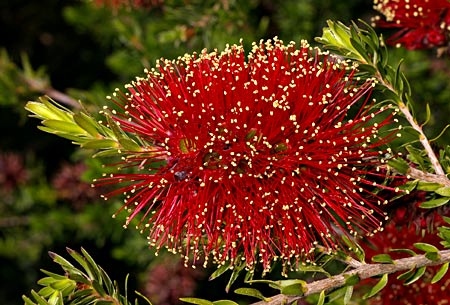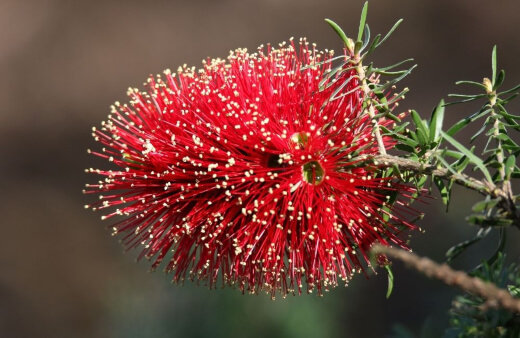Kunzea baxteri is a lesser-known Aussie native that many often mistake for a bottle brush. Although both feature brilliant, red blooms, the Kunzea baxteri does offer some unique features that make a good choice, especially for novice gardeners.
Native to the southern part of Western Australia, this cultivar produces a large red flower and aromatic, dark green foliage. Are you considering this cultivar for your garden? Here is what you’ll need to know.
More...
What is Kunzea baxteri?
Family: Myrtaceae
Genus: Kunzea
Species: K. baxteri
Common Name: Scarlet Kunzea and Crimson Kunzea
Flower Colour: Red
Foliage Colour: Green
Growth Habit: Shrub to 2m
Flowering: Winter to Spring

Photo: Brian Walters
Kunzea baxteri, also known as the Scarlet Kunzea or Crimson Kunzea, forms part of the Myrtaceae family. Although considered a medium-sized shrub, this cultivar can grow as much as 2 metres.
Due to its growth habits and dense foliage, it’s a great option for those looking for a screening or hedging plant for windbreak.
It also works incredibly well as a feature plant. With nectar-rich, brilliantly red blooms, this striking Aussie native will attract a wide range of natural wildlife to your garden.
These blooms will appear in succession, giving you a colour-rich spectacle throughout the winter and spring months.
How to Grow Kunzea baxteri
Growing Kunzea baxteri is quite simple, and once established, will require very little of your attention. It is important to note that the scarlet kunzea prefers growing in regions that experience a hot summer and wet winter. However, it also grows fairly well in humid climates.
More so, one of the best Kunzea baxteri features is that it grows quite happily in shallow, poor soil conditions. As such, any form of sand or loam soil will be ideal, ranging in PH between 5.0 and 7.0.
As the scarlet kunzea is a drought-friendly plant, you will need to ensure well-draining soil. This cultivar should be grown in full sun conditions; however, it can also tolerate some light shade.
Propagating Crimson Kunzea

As with many native plants, this species propagates quite easily from either seed or cutting. For those wanting to grow from seed, it is essential to pay close attention to the parent plant from which you wish to take a seed.
Seeds can easily be lost. More so, if grown from seed, there is a chance that your crimson kunzea will take at least ten years to flower.
Remove the seed from the parent during spring or autumn, then:


Get Your Free Guide:
Master Growing Australian Natives eBook
A Must Have Complete Guide for Every Australian Garden
Get Your Free Guide:
Master Growing Australian Natives eBook
A Must Have Complete Guide for Every Australian Garden
- Sow the seed onto the surface of a well-draining potting mix.
- Taking care not to force the seed into the soil, lightly sprinkle it with some soil.
- Using a mister, lightly spray the soil, allowing the seed to lodge.
- Keep your seedling in a warm, semi-shaded spot to germinate.
- Germination usually takes between 14 to 28 days.
With most Australian native plants, especially when seeds are procured from the wild, there is a chance that the seed is dormant. As such, take care not to throw your failed seedling away too quickly, as it may just need a little extra time.
Cuttings should be taken from mature, already flowering parent plants. These should ideally be taken in late summer. Plants grown from cuttings should begin flowering within three years.
Once new growth has begun to appear, young plants can be planted outdoors during March.
Kunzea baxteri Care Tips
Kunzea baxteri care is rather simple and straightforward. As they are a low-maintenance plant, they won’t need much of your attention once they are established.
Young plants should be watered well up until new growth appears. Thereafter, they will need little to no additional water. Mulching the base is recommended to help retain some moisture around the roots during the hot summer seasons.
The scarlet kunzea responds incredibly well to regular pruning, which makes it a fortifiable hedging plant. Pruning should be done after flowering. Remove any spent flower and cut back any leggy growth.
Here is our review on the best pruning shears for 2025.
The only other aspect of caring for Kunzea baxteri which may be important to note is that it is frost tender. Should you be experiencing a particularly cold winter, it may be beneficial to protect your plant from the frost.
Kunzea baxteri Frequently Asked Questions
How fast does kunzea grow?
Kunzea shrubs take about 12 months to fully establish themselves and reach their mature height in good conditions.
How big do kunzea grow?
Some species are considered small to medium-sized shrubs whereas others can grow to be larger shrubs, both in height and width. Growing conditions, care routine, and the surrounding space can influence how big your kunzea grows.
Can you eat kunzea?
Sweet-scented Kunzea (Kunzea ambigua) is known to be safe for human consumption as the leaves contain essential oils and other micronutrients. These leaves can be steeped in water for a healthy tea or they can be used as a strong flavour in cooked meals like roast meat dishes and vegetable-orientated dishes.
How do you propagate kunzea plants?
Most species will propagate readily using semi-hardwood cuttings taken in early summer. They can also be grown from seed but these plants can take up to 7 years to flower whereas cuttings can take only 2 to 3 years.
Where does kunzea grow?
Many of the popular species of Kunzea are found occurring naturally across the coastal strips and plateaus of eastern Australia. Others have acclimated themselves to other states.
Why is kunzea called tick bush?
Many have witnessed animals seeking shelter under the branches of the kunzea plants and it was believed that this provided the animals with protection from ticks and mites, hence this common name was soon adopted.
Kunzea baxteri Final Tips
One of the Kunzea baxteri features is that it can tend to develop light-scale if the growth area is too shaded. Be sure to give your scarlet kunzea plenty of sun.
- This cultivar is very sensitive to phosphorous, so it is good to check the soil regularly.
- While it’s not necessary, a general-purpose fertiliser can be used as part of your Kunzea baxteri care.

Start Growing Your Kunzea baxteri Today!
If you’re looking for some other natives to grow alongside your Kunzea baxteri, you can check out all of the kunzea growing guides:
As long as your scarlet kunzea remains in a sunny spot with plenty of well-draining soil, it should have no issues of note. Plus, you’ll be able to enjoy the incredible wildlife this fantastic flowering cultivar will bring to your garden. So, there you have it! Everything that you need to know about Kunzea baxteri.
Published on August 26, 2021 by Nathan Schwartz
Last Updated on January 26, 2025





